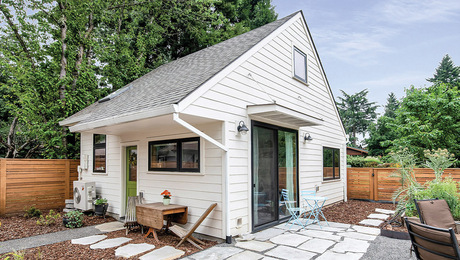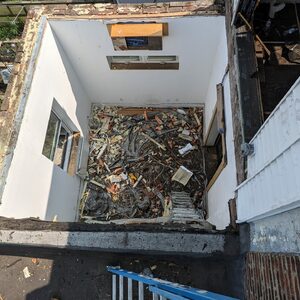Radiant Electric Heat is offered as a heating solution for a cottage I’m building. I’m wondering what is hype & what is real.
WWW.electricheat.com is the source I’m having quote the parts. The center of the quandary is this phrase:
“Efficient use of electricity…Heats people not empty space.”
I guess I’m confused. It is supposed to be an infra red heat source. It mounts easily, the wiring is simple, and the maintenance is limited to dusting.
Anyone have a comparison to a high efficiency gas furnace? I suspect electricity is more expensive per heat unit than gas, but the strength of this is supposed to be in the fact that this heats the objects and not the air.
It differs from other electric heaters they say but I’m not sure how.



















Replies
Well you can get radiant and infra red heat in gas also.
But all of the gas infra red heaters that I have seen have been designed for garage/warehouse/outdoor use.
But no mater how efficient the electric is if you are paying 20 cents a KWH and have a fee gas well in the back yard then it isn't cost effective.
The first thing is that you need to find out what your local rate structure is.
Also you called this a cottage. Does that imply that it will be used infrequently and that maybe it is winterized most of the winter.
Yep it will be winterized, although it is well insulated the thought to heat it all winter seems silly.
Electricity is $0.075 per KWH plus about 8 percent in various taxes & fees.
In BTU's The energy calculation is about 60,000 at the coldest.
Booch,
A typical comparison for gas vs electric heat.
The average cost of residential electricity in the lower 48 is about $0.08/kwh and natural gas runs anywhere from $0.30 to $1.00/therm, normally, the average being around $0.50/therm. In low supply/high demand, the price can exceed $2.00/therm. A therm = 100,000 btu.
1 kilowatt = 3413 btu/hour, used over the period of 1 hour = 1 kilowatt-hour (kwh).
For a heat loss at 50,000 btu/hour the cost to operat a 90% efficient furnace, that has a 1/4 hp blower motor is:
5.8Ax120V 696w=0.696 kwh x 0.08= 0.06 +
50,000 btu/0.9= 55,556 btu input /100,000 = 0.556 therm x 0.5 = 0.27
= total/hour about $0.34, if gas cost $1.50/therm (very high cost for NG) total = $0.89
for the same energy into the space with electicity:
50,000 btu/3413 = 14.6 kw x 0.08 = $1.17, if electricity cost $0.04/kwh (a very low cost) = $ 0.59.
So unless gas is VERY expensive in your area and/or electicity is VERY cheap, gas wins the price war easily.
I have LP as fuel at my house and contract for $0.84/gallon. I figured that at $1.00/gallon, electricity would have to cost me less than $0.035/kwh to be equal. Never going to happen in my neck of the woods.
Lp is $.86/gal here.
Thanks, I just left the place and I'm having the P&H guys install the furnace. sealed combustion Armstrong 80Kbtu.
After your post I was convinced this type of heating is great for an outdoor hotdog stand but in the house it would be silly. If I had alergy problems or an aversion to a gas furnace then it would make sense. It is an interesting phenomonon but it doesn't seem right for this application.
Financially I don't have any gain I can see. Thanks for making this resolved in my mind.
Booch.... we've used electric radiant heat since the mid-70's... the ones we use are the electric cove heaters... you can see them in a Grainger's catalogue..
they look like long panels about 3" thick... 4" high and anywheres from 3' to 10' long.. they mount on the walls about 5" below the ceiling...
they are faster response than electric convector heaters.. they do heat objects which in turn heats the air..
they will radiate right out a window.. so it's best to mount them on exterior walls.. their installed cost is very low compared to a boiler or hot air heater so the pay back can be as quick as 3 years or so... the benefit is no combustion products.. no chimney... a more efficient use of electricity than baseboard convection heaters... fast response... easy on / off..pretty ideal for a weekend vacation home..
drawbacks.. higher operating cost.... some don't like them mounted on a wall
since our house is heated by solar hot air about 60% of the time.. they do make an ideal backup heat source for the solar...
Mike Smith Rhode Island : Design / Build / Repair / Restore
They truely look like a good heating source but it is hard to imagine that many "Pods" hanging off the wall. Still it seems a good way to warm the room as a backup to the sun.
As I wrote above my die is cast as I just turned on the P&H contractor to finish the LP Gas furnace.
Like yourself there are many enthusiasts in the country that appreciate this heat source. If I wasn't in the Frozen Tundra I would have gone that way. As it is, the need for heat is not a supplementary concern in my neighborhood.
Just out of curiosity, how do you control the heat? is there a collection of thermostats, one in each room? What about switching the power to the heating elements. Is that (the power switching) done with a contactor in a box run by the thermostat?
the solar hot air is central and controlled by one thermostat.. if it doesn't have enough heat to satisfy.. the rooms start getting colder... each room has it's own electric heat thermostat which we set at what ever we want... so for example... in the family room.. if the solar doesn't satisfy.. it cools down to say 65.. the radiant heat calls and maintains 65... as the solar gains heat, the electric heat shuts off... (KISS)Mike Smith Rhode Island : Design / Build / Repair / Restore
"Lp is $.86/gal here."
Not a bad price. I had all electric baseboard heat in the house I own and pay around $0.07/kwh. At $1.00/gallon for LP and a 90% furnace, LP was less than 50% of the cost to heat with electricity.
"... sealed combustion Armstrong 80Kbtu." 80,000 btu/hour (btuh) would typically designated as 80 Mbh. no kilo's with btu's. I don't know why.
"If I had alergy problems or an aversion to a gas furnace.." I couldn't address any aversions, but if you did have allergies, a forced air furnace, with the right accesories and set up properly, would be more beneficial for your breathing than any other type of heating. The wetheads will disagree, but they're wrong.
"... sealed combustion Armstrong 80Kbtu." 80,000 btu/hour (btuh) would typically designated as 80 Mbh. no kilo's with btu's. I don't know why. "
I work selling electrical products to industry. The world there is M,D,C,L,X. for piece parts (wire ties and the like), Watts (VA) is K. Never really thought about it. I guess it is Kilo-Watts. Must be some arcane europeen reference/language. Not that M from Latin is any less arcane.
Commerical vs scientific notation.
M,D,C,L,X are from the Roman numerials and as you said they are often used for counting parts and the like.
Kilo, mega, deca, micro, etc are from the greek are are used as prefixes to scienctific measurements.
Beside power you will see them used on the parameters of the parts that you sell (resistance, capacitance, leakage, etc), almost any medical parameters, computers (mega bytes) and the like.